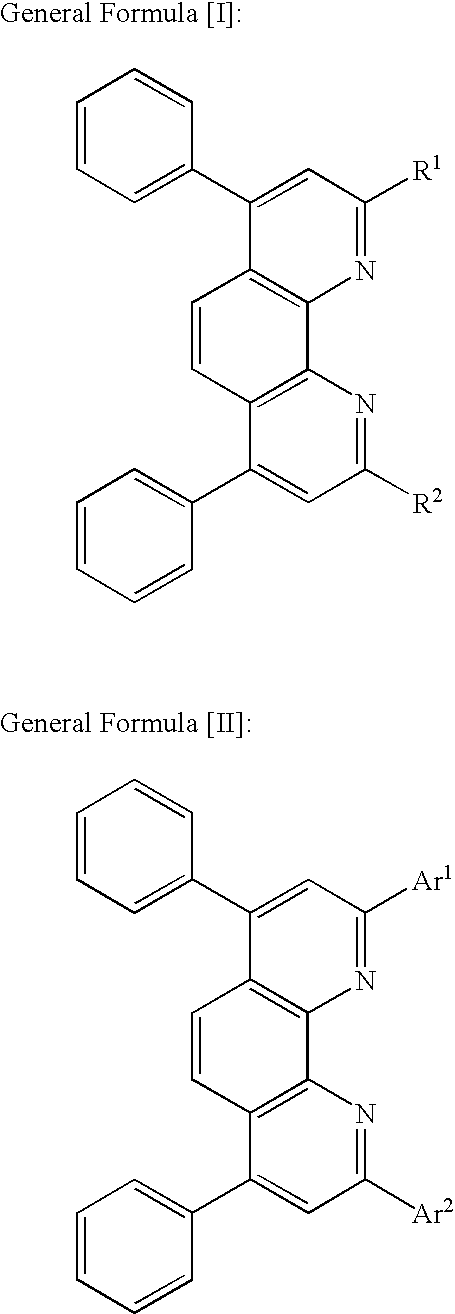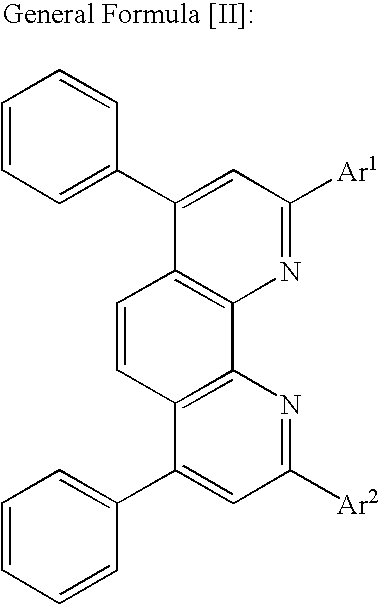Optical recording medium
a technology of optical recording medium and optical recording medium, which is applied in the direction of discharge tube luminescnet screen, other domestic articles, natural mineral layered products, etc., can solve the problems of limited use of optical recording medium, short service time, and shortened service life, and achieve efficient electron transport
- Summary
- Abstract
- Description
- Claims
- Application Information
AI Technical Summary
Benefits of technology
Problems solved by technology
Method used
Image
Examples
example 2
[0100]
[0101] The reaction sequence is shown below 49
[0102] n-Butyl lithium (1.6 M n-hexane solution, 60.2 ml, 96.3 mmol) was gradually dropped in an n-hexane / anhydrous diethyl ether (10:1) solution (110 ml) of 2-bromo-m-xylene (17.8 g, 96.3 mmol) at room temperature. After completion of the dropping, the reaction solution was heated under reflux for 2 hours and further agitated at room temperature for 16 hours, and the resultant product was separated by filtration, followed by washing of the resulting white solids with n-hexane (50 ml.times.3 times). A toluene solution (80 ml) of bathophenanthroline (5.09 g, 15.3 mmol) was gradually dropped, at room temperature, in an anhydrous diethyl ether solution (40 ml) of the resulting white solids. After completion of the dropping, the solution was heated under reflux for 2 hours and agitated at room temperature for 16 hours.
[0103] 60 ml of iced water was gradually added to t...
example 3
[0108]
[0109] The reaction sequence is shown below 50
[0110] n-Butyl lithium (1.6 M n-hexane solution, 15.3 ml, 24.4 mmol) was gradually dropped, at 0.degree. C., in an n-hexane / anhydrous diethyl ether (1:1) solution (60 ml) of 1-bromonaphthalene (5.01 g, 24.4 mmol). After completion of the dropping, the reaction solution was agitated at room temperature for 16 hours, and the resultant product was subsequently separated by filtration, and the residue was washed with n-hexane (40 ml.times.3 times). A toluene solution (80 ml) of bathophenanthroline (2.03 g, 6.11 mmol) was gradually dropped, at room temperature, in an anhydrous diethyl ether solution (40 ml) of the resulting solids. After completion of the dropping, the reaction solution was agitated at room temperature for 16 hours.
[0111] 60 ml of iced water was gradually added to the resultant reaction solution to separate an organic layer therefrom. The aqueous layer was extracted three times with chloroform, and the resultant organi...
example 4
[0115]
[0116] The reaction sequence is shown below 51
[0117] Lithium diisopropylamine (LDA) (1.89 g, 17.4 mmol) was added to a THF solution (30 ml) of fluorene (4.16 g, 25.0 mmol) and agitated at room temperature for 16 hours. Thereafter, the THF and diisopropylamine were removed by distillation under reduced pressure. A toluene solution (60 ml) of bathophenanthroline (2.03 g, 6.11 mmol) was gradually dropped in an anhydrous diethyl ether solution (20 ml) of the resultant yellow solids at room temperature. After the dropping, the reaction solution was heated under reflux for 2 hours and agitated at room temperature for 16 hours.
[0118] 60 ml of iced water was gradually added to the resultant reaction solution to separate an organic layer therefrom. The aqueous layer was extracted three times with chloroform, and the resultant organic layer was mixed with the previously separated organic layer. 60 g of manganese dioxide (chemically treated product) was added to the thus mixed organic l...
PUM
| Property | Measurement | Unit |
|---|---|---|
| Transparency | aaaaa | aaaaa |
| Brightness | aaaaa | aaaaa |
Abstract
Description
Claims
Application Information
 Login to View More
Login to View More - R&D
- Intellectual Property
- Life Sciences
- Materials
- Tech Scout
- Unparalleled Data Quality
- Higher Quality Content
- 60% Fewer Hallucinations
Browse by: Latest US Patents, China's latest patents, Technical Efficacy Thesaurus, Application Domain, Technology Topic, Popular Technical Reports.
© 2025 PatSnap. All rights reserved.Legal|Privacy policy|Modern Slavery Act Transparency Statement|Sitemap|About US| Contact US: help@patsnap.com



